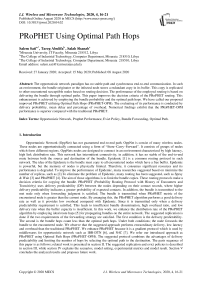PRoPHET Using Optimal Path Hops
Автор: Salem Sati, Tareg Abulifa, Salah Shanab
Журнал: International Journal of Wireless and Microwave Technologies @ijwmt
Статья в выпуске: 4 Vol.10, 2020 года.
Бесплатный доступ
The opportunistic network paradigm has no stable path and synchronous end-to-end communication. In such an environment, the bundle originator or the infected node stores a redundant copy in its buffer. This copy is replicated to other encountered susceptible nodes based on routing decision. The performance of the employed routing is based on delivering the bundle through optimal paths. This paper improves the decision criteria of the PRoPHET routing. This enhancement is achieved by employing the bundle probability and the optimal path hops. We have called our proposed improved PRoPHET utilizing Optimal Path Hops (PRoPHET-OPH). The evaluating of its performance is conducted by delivery probability, mean delay and percentage of overhead. Numerical findings exhibit that the PRoPHET-OPH performance is superior compared with the traditional PRoPHET.
Opportunistic Network, Prophet Performance, Evict Policy, Bundle Forwarding, Optimal Path
Короткий адрес: https://sciup.org/15017643
IDR: 15017643 | DOI: 10.5815/ijwmt.2020.04.02
Список литературы PRoPHET Using Optimal Path Hops
- A. Vahdat, D. Becker et al., “Epidemic Routing for Partially Connected Ad hoc Networks,” Technical Report CS-200006, Duke University, Tech. Rep., April 2000.
- S. Sati, A. Sohoub, A. Eltahar, K. A. B. Ahmad, K. Ahmad, and A. Bakeer, “Degree Contact DC-Epidemic Routing Protocol For Opportunistic Networks,” in Proceedings of Advances in Wireless and Optical Communications (RTUWO), pp. 198–203, November 15-16, 2018, Riga, Latvia, 2018.
- T. Spyropoulos and K. Psounis, “ Spray and Wait: An Efficient Routing Scheme for Intermittently Connected Mobile Networks ,” Proceedings of the ACM SIGCOMM Workshop on Delay-Tolerant Networking, , 2005.
- A. Lindgren, A. Doria, E. Davies, and S. Grasic, “RFC 6693: Probabilistic Routing Protocol for Intermittently Connected Networks,” IETF, 2012.
- R. Gu´erin and A. Orda, “Computing shortest paths for any number of hops,” IEEE/ACM Trans. On Netw., vol. 10, no. 5, pp. 613–620, 2002.
- M. Doering, S. Lahde, J. Morgenroth, and L. C. Wolf, “IBR-DTN: an efficient implementation for embedded systems,” in Proceedings of the Third Workshop on Challenged Networks, CHANTS 2008, San Francisco, 2008, pp. 117–120, California, USA, September 15, 2008.
- N4C, “Functional specification for dtn infrastructure software,” 2008. [Online]. Available: http://www.n4c.eu/N4C-info.php
- T. Huang, C. Lee, and L. Chen, “Prophet+: An adaptive prophet-based routing protocol for opportunistic network,” in 24th IEEE International Conference on Advanced Information Networking and Applications, AINA 2010, pp. 112–119, Perth, Australia, 20-13 April 2010, 2010.
- P. Sok and K. Kim, “Distance-based prophet routing protocol in disruption tolerant network,” in Proceedings of the International Conference on ICT Convergence (ICTC ’13), pp. 159–164, Jeju , Korea , October 2013.
- A. E. Ouadrhiri, M. El-Kamili, M. R. El-Fenni, and L. Omari, “New forwarding strategy for PRoPHET routing in delay tolerant networks ” in Networked Systems - First International Conference, NETYS 2013, pp. 300–305, Marrakech, Morocco, May 2-4, 2013, Revised Selected Papers, 2013.
- B. B. Bista and D. B. Rawat, “Ea-PRoPHET: An energy aware PRoPHET based routing protocol for delay tolerant networks,” in 31st IEEE International Conference on Advanced Information Networking and Applications, AINA 2017, pp. 670–677, Taipei, Taiwan, March 27-29, 2017, 2017.
- S. Sati, C. Probst, and K. Graffi, “Implementing forward and drop policies for improving PRoPHET’s routing performance,” in 12th International Conference on Mobile Ad-Hoc and Sensor Networks, MSN 2016, pp. 236–242, Hefei, China, December 16-18, 2016, 2016.
- S. Bayhan, E. Hyyti¨a, J. Kangasharju, and J. Ott, “Analysis of hop limit in opportunistic networks by static and time-aggregated graphs,” in 2015 IEEE International Conference on Communications, ICC 2015, pp. 3287–3292, London, United Kingdom, June 8-12, 2015, 2015.
- E. Bulut, Z. Wang, and B. K. Szymanski, “Cost-effective multi period spraying for routing in delay-tolerant networks,” IEEE/ACM Trans. Netw., vol. 18, no. 5, pp. 1530–1543, 2010.
- S. Sati, K. Ahmad, “Efficient evict policy for PRoPHET“. International Journal of Information Technology. vol 12, issues 1, pp 251–260 (2020). https://doi.org/10.1007/s41870-019-00359-x.
- A. Ker¨anen, J. Ott, and T. K¨arkk¨ainen, “The ONE Simulator for DTN Protocol Evaluation,” in Proceedings of the International Conference on Simulation Tools and Techniques for Communications, Networks and Systems (SimuTools). ICST/ACM, 2009.


